I’m very excited about today’s post as it is the first in my series of Creative Pastimes.
And the first creative pastime that I’m going to share with you in my absolute favourite crochet!
As I mentioned in So, what is Creativity? I plan to explore creativity in three different ways with the first being by trialling and sharing my experience with various art forms and creative pastimes. So basically the aim of this series is to try a whole bunch of different creative activities and hobbies and tell you about the whole process – the successes, the failures, what I learned – the whole lot! All with the aim of having a lot of fun and highlighting the benefits of creativity in your life.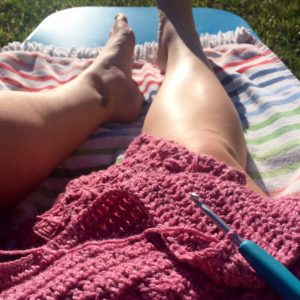
Now when I say I’m going to share the failures, I really mean it, and it’s not just for laughs. I hope that by letting you see my mistakes that you’ll come to understand that mucking up, especially when you’re learning, is not just OK but it’s one of the essential reasons that a creative hobby is good for us. I’ll talk more about making mistakes in a separate post but I want to be clear about how important this aspect of creativity is. I’m going to be vulnerable with you and try to show you more than just the picture perfect, styled flat lays of finished items that we all drool over on Instagram. I want you to feel inspired and empowered by this series, as well as introducing you to some awesome creative pastimes!
So let’s introduce you to my first Creative Pastime.
Crochet
What is crochet?
Crochet is a handicraft in which yarn is made up into a textured fabric by means of a hooked needle. There are many different traditional crafts throughout human history which involve making fabric from yarn – knitting, weaving, etc – and crochet is distinguished from them by the hook used to make it.
What equipment do you need?
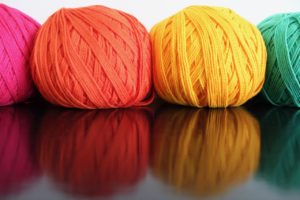
Yarn: you can use any yarn you like. Different fibres: wool, cotton, acrylic, cashmere, silk, etc. Different thicknesses: from sewing thread to super bulky roving and everything in between.
Hook: this is essentially a smooth stick with a hook on the end that you can poke through stitches, wrap the yarn around and the hook helps hold it on the stick! Hooks are made from many different materials: wood, metal, plastic, bamboo, etc. and come in many different sizes. In general you match the hook size to the yarn and project, the rest comes down to personal preference and price.
Additional but not always necessary equipment
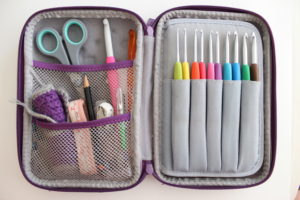
- stitch markers to mark your place or stop the work from unravelling when you’re not working on it. I used safety pins to begin with and now use pretty lobster clasp stitch markers, though you can purchase all sorts of different ones.
- darning needle. These come in different sizes and are used to weave the end of your yarn in when you finish your colour or work.
- scissors. These are pretty necessary actually but you can just use any scissors you have or get small sharp scissors like embroidery scissors to cut your yarn.
- notebook to keep track of your projects. I like to write down the yarn and hook I’m using as well as the pattern name and any other notes I need to remember.
- project bag or basket to keep your yarn tidy and clean.
Where can you do it?
One of the things I love about crochet is that it is easily portable and I can crochet anywhere. I usually crochet in my armchair but I’ve also crocheted at my desk, in bed, in the car, sitting on the driveway, at the park and on the banana lounge in the back yard! Some people can even crochet whilst they walk and many people crochet as they commute on public transport.
How much time does it take?
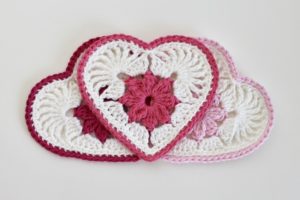 Well it really depends on the project and your personal speed but it is very easy to pick up and put down which means you can crochet in any spare minutes you have, like when you’re sitting in the car waiting to pick up your kids. I really appreciate this aspect as a stay at home mum with a small child who always needs me at a seconds notice 🙂 and with crochet I can just set it aside and come back to it as soon as the disaster has been taken care of!
Well it really depends on the project and your personal speed but it is very easy to pick up and put down which means you can crochet in any spare minutes you have, like when you’re sitting in the car waiting to pick up your kids. I really appreciate this aspect as a stay at home mum with a small child who always needs me at a seconds notice 🙂 and with crochet I can just set it aside and come back to it as soon as the disaster has been taken care of!
As for how long it takes to make a project, well I’m a slow and steady crocheter and for example it takes me about 45 minutes to make one Heart in Bloom (left) with all the ends woven in and I know that pattern by heart! A small coaster may take as little as 20 minutes and a large blanket may takes weeks or months. I have a granny square blanket (120 six round granny squares with a colour change each row) that I’ve been working on for over 2 years! Projects in finer yarns generally take longer that ones made with bulky yarn and the complexity and style of the pattern will also affect how long it takes.
What can you make with it? What are the end results like?
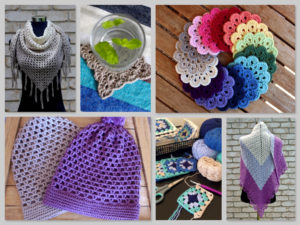 As the description above states, crochet makes a textured fabric. This is a very broad definition but it also gives you an idea of how flexible crochet is when it comes to what you can make.
As the description above states, crochet makes a textured fabric. This is a very broad definition but it also gives you an idea of how flexible crochet is when it comes to what you can make.
Here are some examples: blankets (one of the most popular things to crochet); coasters, placemats, hot pads, kitchen stuff; face washers, soap savers, bathroom stuff; pillow cases; scarves, hats, gloves, necklaces and other accessories; clothes like jumpers, t-shirts, skirts, dresses, bikinis, shorts, ponchos and more; decorative pieces like doilies, wall hangings, bunting, etc.; toys like baby rattles and balls, loveys, amigurumi, dolls; well I think you get the picture!
How can you learn to do it?
There are many different ways to learn to crochet. I learned online by watching YouTube videos and reading tutorials.
Here are some different ways to learn to crochet.
- someone you know who crochets could teach you.
- look for classes in your local area.
- books. There are heaps of learn to crochet books. Check out your local library, book store, craft store or an online book store.
- online tutorials. Lots of blogs and yarn companies have great free material to help you learn how to crochet.
- YouTube. There are seriously so many awesome people making wonderful videos to help you learn how to do all sorts of things on YouTube.
I’ve provided some links to various resources that I have used and continue to use below, including some beginners courses.
What are the positives, negatives and interesting things about crochet?
Positives: you can make so many different things that you’re sure to find something you’d like to make; highly portable and super easy to fit into even the smallest bits of free time; it’s not expensive to get started – some reasonably priced yarn and a basic hook and you’re good to go; can be incredibly relaxing especially when working on something simple that you know well; can also be rewardingly challenging like when working on something big and beautiful with new stitches; there’s a fantastic community of crocheters out there of all ages, genders and cultures who all come together through their love of crochet.
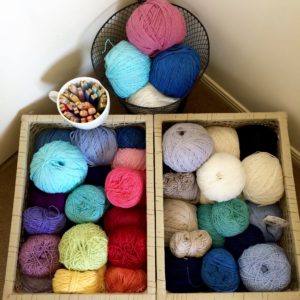
Negatives: hmmmm, this one’s hard for me as I love it but I’ll try not to be too biased. It can be overwhelming with how many options there are. I have amassed over 1,000 crochet related pins on Pinterest in the 3 years I’ve been crocheting. I’d recommend starting with the good old granny square, a simple scarf or a blanket. You may end up with an excess of finished objects you don’t know what to do with (try donating blankets, hats, etc. to a charity so you can keep crocheting). Yarn stash – the temptation to buy too much pretty yarn is high which can take up space and money.
Interesting: There are 2 different versions of crochet terminology in English. UK and US, and whilst they sound the same they are slightly different.
Eg. A UK double crochet is a US single crochet.
A UK treble crochet is a US double crochet.
You can also use symbols to create a crochet pattern.
Check the pattern terminology before you start!
The names of yarn thicknesses and hook sizes vary too depending on where you are and the yarn company.
Eg. Australian 8ply is approximately US DK weight.
Australian 4ply is approximately US fingering weight.
Metric 4mm hook is a US G and a 5mm is a US H.
You can find comparison charts online to help with this.
My personal experience.
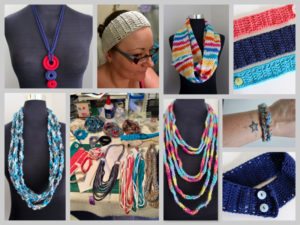
After rediscovering my creative side (see How creativity helped me find myself again for more about this) I began to play around with what I now know is finger crochet. I made myself a chain stitch necklace scarf (bottom left photo) with some lovely yarn I had lying around and told my Mum about it. She said that it sounded like crochet and maybe I should give it a try – so I did! And I haven’t looked back.
I watched videos and read online tutorials, I bought myself a set of plastic hooks from Spotlight as well as some cotton/acrylic yarn, I learnt how to do a double crochet, then a wonky granny square.
At this point I made a lot of basic ear warmers and wrist cuffs. I moved onto making necklaces with circles crocheted around washers and a couple of moss stitch scarves in self striping yarn – I was seriously loving it and I was so proud of what I was able to make with a hook and some yarn.
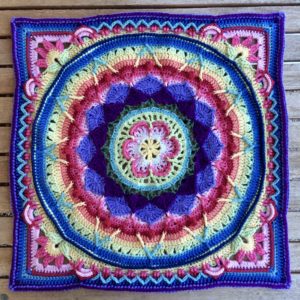
Not everything was a success but a lot of what I didn’t like I frogged and tried again until I was happier with it. After a year or so of crocheting very simple things I started 2 big projects (both of which I’m still working on!) – a granny square blanket in beachy colours and Sophie’s Universe (left) by the amazing Dedri of Look at What I Made. Sophie’s Universe taught me so much and gave me so much confidence – the written instructions, the photo and videos tutorials, the extra tips and tricks provided, just everything about it was amazing for a beginner like me. It gave me such a boost – even though my trebles are too loose and the centre bows out! I was ready to try new things and I even started creating my own designs.
Thanks to the fantastic array of resources available, from so many beautiful people out there willing to share their expertise, I feel like I can do anything I put my mind to now.
What do I feel are the benefits of crochet?
One of the things I love about crochet is that it is a very forgiving art form to learn. In general when you make a mistake you can pull the stitches out and try again – this is called frogging as you ‘rip it, rip it’ out! You can frog a single stitch, a whole row or a whole project and use the yarn again. This makes crochet a great creative pastimes for people who are concerned with mucking up. It is also a hobby that uses simple movements that are reasonably easy to learn and don’t require a huge amount of fine motor control, making this a great activity for creative beginners young or old.
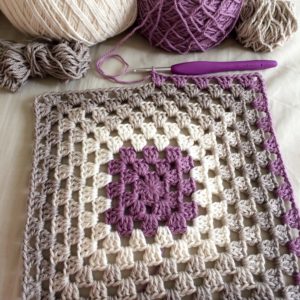 Crochet is also very soothing once you get the hang of it. When working a simple well known pattern, like a granny square, there is a rhythm that I find helps quiet my mind. I like that it is relaxing and I feel I am accomplishing something too. Then when I feel like being more engaged I can work on a complex pattern and push my limits learning something new. This makes crochet a hobby that can flex with your moods and change with your growing skills and desires.
Crochet is also very soothing once you get the hang of it. When working a simple well known pattern, like a granny square, there is a rhythm that I find helps quiet my mind. I like that it is relaxing and I feel I am accomplishing something too. Then when I feel like being more engaged I can work on a complex pattern and push my limits learning something new. This makes crochet a hobby that can flex with your moods and change with your growing skills and desires.
I hope this has given you some insight into why I love crochet so much as well as inspiring you to give it a try or to try something new if you already crochet.
Next month I’ll be looking into the world of colouring, a childhood favourite of mine. From adult colouring books to colouring apps this is a very accessible art form that can be very rewarding for both new and old creative souls.
Learn to Crochet Resources
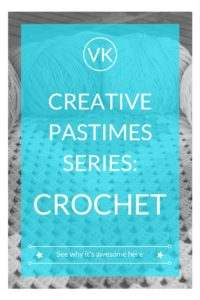 Moogly: http://www.mooglyblog.com/learn-how-to-crochet/ for right and left handers and lots of other other great information.
Moogly: http://www.mooglyblog.com/learn-how-to-crochet/ for right and left handers and lots of other other great information.- Attic 24: http://attic24.typepad.com/weblog/neat-ripple-pattern.html and other great tutorials.
- Simply Daisy: https://www.youtube.com/playlist?list=PLu8-BXDggCu8z0bJ1dBiEG5t5oLIJz6A3 Beginners course.
- The Crochet Crowd: http://thecrochetcrowd.com/free-online-crochet-workshop-for-beginners/ Beginners course.
- Look at What I Made: http://www.lookatwhatimade.net/free-crochet-patterns-tutorials/ some really good info and excellent tutorials to go with patterns.
- Lion Brand: http://www.lionbrand.com/learn/how-to-crochet Beginners course.
- Spincushions: https://spincushions.com/crochet-ebooks/ Granny square crochet for beginners in both US and UK terms.

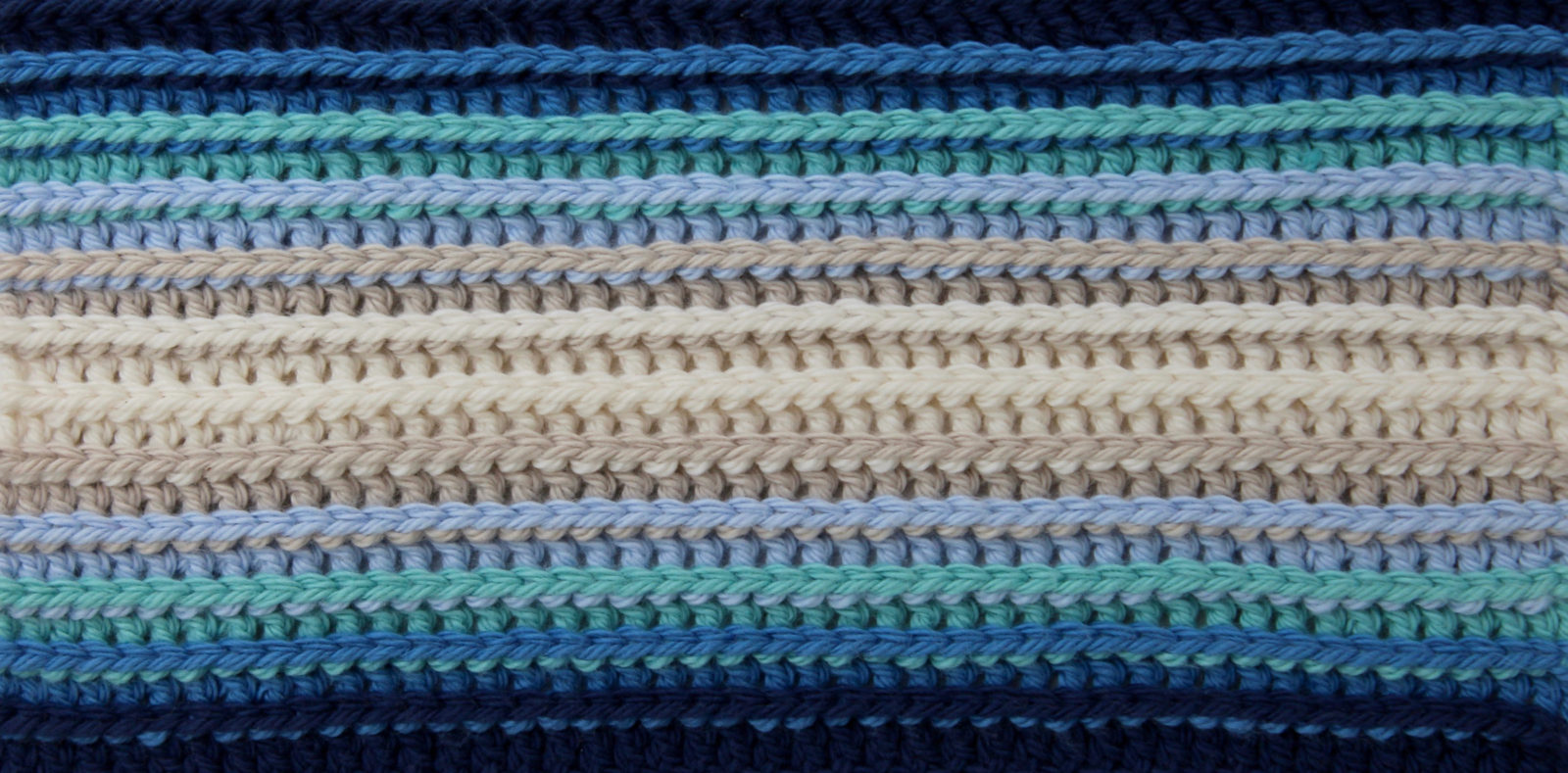

Mikaela,
What is your preferred method for taking care of loose ends? I’ve tried several methods, but I’m not really happy with any of them.
Thanks!
Deb
I like to weave my ends in with a yarn needle. No quick fix – I’m always worried they will come out so I do a thorough job. I generally weave through the stitches going back and forth with a kind of loop, so the end crosses over itself.
For example: I’ll go though the bottom of the stitches across a row left to right, then go down a row, left a stitch, up a row again then continue across a few more stitches to the right and repeat. The idea is that you change direction multiple times and maybe split the yarn you are weaving making it more secure.
I’m working on a tutorial for the Double Magic Circle and I show how I weave my end in for that which might give you a better idea of what I mean. If not I could do a tutorial for general weaving in if you’re interested.